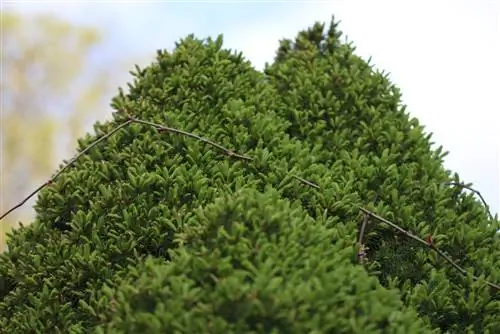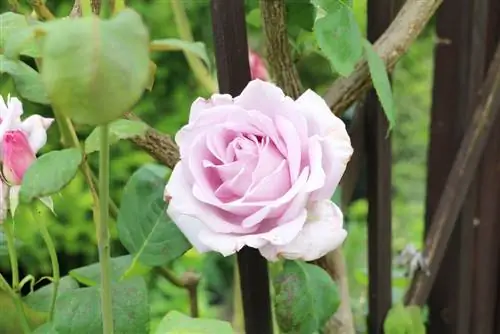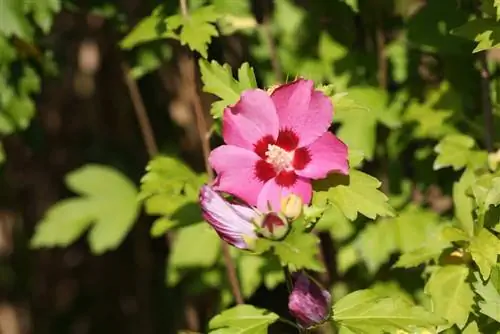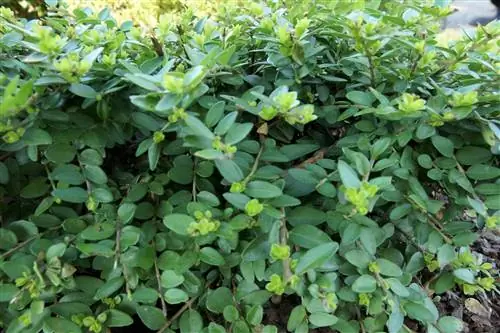- Author admin [email protected].
- Public 2023-12-17 03:39.
- Last modified 2025-01-24 12:45.
If there is little space in the garden or there is only a terrace or balcony, then the sugarloaf spruce is the right tree because it is relatively small and can also be cultivated in a container. The compact growth is very dense due to the small, fine needles and is therefore reminiscent of a sugar loaf. If it is given the right location without being in direct proximity to other plants, it will develop splendidly, as the sugarloaf spruce is generally very robust.
Location
The sugarloaf spruce has the greatest demands on its location. It cannot tolerate other plants being placed in close proximity. If it is pressured or even touched by them, its needles will turn brown in these places if this continues over a longer period of time. Therefore, you should always find a location for the sugarloaf spruce where it can develop completely on its own, be it in the garden or in a pot on the balcony or terrace. You should also keep enough distance from a wall or fence that the sugarloaf spruce could touch. The damage to the areas touched is usually irreparable; unsightly holes appear in the compact growth that no longer grow over. Otherwise, the following should be offered to the sugarloaf spruce at the location:
- sunny to partially shaded
- very bright
- Long periods of time in the shade can make her feel bad
- always as a solitaire
- If planting in a group, make sure there is enough distance
- sufficient distance from walls or fences
- cultivated on a grave, distance from the gravestone
- suitable for stone and heather gardens
- a sunny front garden
Tip:
Since the sugarloaf spruce only grows a little between 1.50 and 2.50 cm, it is often used as a grave plant.
Substrate & Soil
The Sugarloaf spruce originally comes from the mountainous areas of Canada and North America. It doesn't stay dry here for long, which is why she wants soil that retains moisture, even in these latitudes. Otherwise the floor should have the following characteristics:
- permeable
- Mix garden soil with sand and peat
- Use potting soil for potted plants in the pot
- neutral to sour
- slightly moist, without waterlogging
Plants
In the following you can find out how to plant the sugarloaf spruce in the container and in the garden. Read more about this:
Planting in a bucket
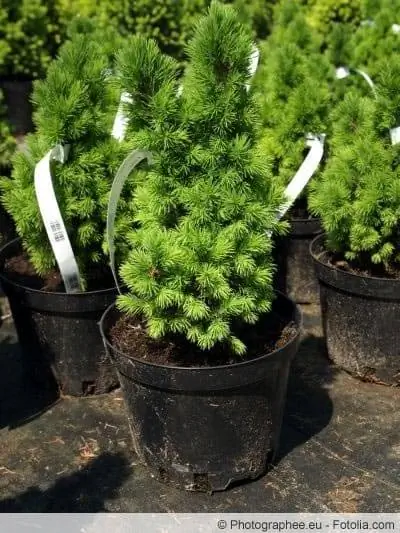
Since the sugarloaf spruce is a relatively small tree, it is well suited for balconies and terraces and can be cultivated in a pot. However, no other plants should be used in these. The location for the bucket must also be chosen with foresight. This should not be in direct proximity to the wall of the house and the place should be predominantly sunny. Especially in the pot, there is a very high risk of waterlogging, which the coniferous tree cannot tolerate despite its desire for a lot of moisture. In such a case, the roots rot and the coniferous tree as a whole can no longer be saved. Therefore, the following should be taken into account when planting in a pot:
- create a drainage over the drain hole
- use pebbles or old pottery shards
- Put plant fleece over it so that soil cannot block the drain
- only then is the prepared soil filled in
- place the sugarloaf spruce in a pot with water
- the roots can soak up water
- then place on the ground in the bucket
- Carefully spread the remaining soil and press it lightly
- water so that the soil is moist
- Remove excess water from the plate half an hour after watering
Tip:
Even if the sugarloaf spruce is hardy, the bucket should be wrapped with plant fleece or jute mats in winter. It can also be placed on a Styrofoam plate. This means the roots in the pot are not damaged.
Repotting
The conifer grows very slowly, so annual repotting into a larger pot is not necessary. This can be done every few years. But to give the plant new substrate, it can be removed from its container once a year or every two years so that the soil can be replaced. When inserting, proceed in the same way as when planting in a pot.
Tip: If the sugarloaf spruce has been cultivated in a pot on the balcony or terrace, it can also be decorated as a Christmas tree outside during Advent and Christmas and provided with lights. At the same time, it can also be brought indoors with its bucket during this time and used as a Christmas tree in the living room.
Planting in the bed
If the sugarloaf spruce is to be cultivated in a bed in the garden or front yard, then it should ideally be planted as a solitary plant. Since the coniferous wood prefers permeable, moist soil, heavy garden soil must be loosened up; mixing in peat and compost is particularly suitable for this. When planting, you should proceed as follows:
- Put sugarloaf spruce in a pot of water
- so the root ball can soak up water
- Dig a sufficiently large hole at a suitable location
- check beforehand whether it is far enough away from any hurdles
- put the soil in a wheelbarrow
- here it can be mixed better
- create drainage at the bottom of the planting hole
- How to avoid waterlogging
- to do this, place stones or gravel in the planting hole
- Insert sugarloaf spruce
- fill in prepared soil again and press down lightly
- pour well
Tip:
For an attractive garden in winter, in which the sugarloaf spruce fits wonderfully, a heather garden with false berries and heather plants could be created, which are also hardy and even develop their flowers in winter. During Advent and Christmas, this can then be decorated with candles and lights. A bed like this also fits well in a front garden.
Transplanting
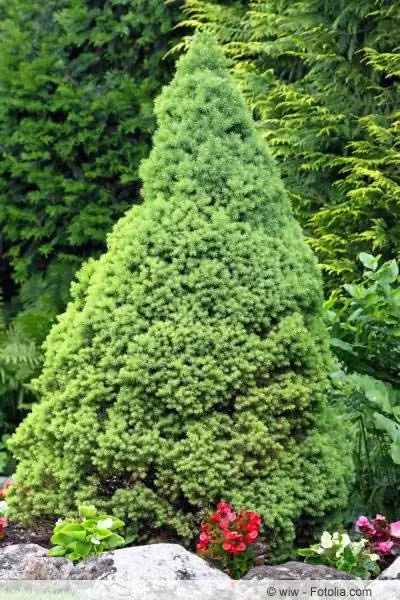
It may well happen that the sugarloaf spruce was not cultivated in a suitable location for it. If the first brown discoloration of the needles appears and it receives regular water and does not suffer from waterlogging, then the chosen location may well be unfavorable for the plant. Over time, the location you once selected may no longer be ideal for the coniferous tree for other reasons. Plants in the immediate vicinity may have grown too large and are depriving you of the sun you need. But a mistake when planting for the first time, without taking into account that the sugarloaf spruce will grow larger after a few years and touch an adjacent wall or gravestone, can also occur. In such a case, action should be taken and the spruce planted. This is quite feasible due to their small size. The following should be noted:
- find a suitable new location
- If there is no suitable location in the garden, changing it will be of no use
- proceed when transplanting as when planting
Tip:
If there is no new, suitable location for the sugarloaf spruce in the garden or front yard, it can also be cultivated in a bucket if conditions are better on the terrace or balcony. If there is no possibility of finding a suitable location for transplanting in your own area, it makes more sense to give the coniferous tree away to a neighbor or acquaintance who can provide the appropriate environment.
Cutting
The sugarloaf spruce does not and should not be cut. Since it grows so compactly, cutting it would spoil the graceful image. Since it grows very slowly and doesn't get too big, it doesn't need to be cut. A cut can only be made in brown areas. But the holes that result from this can no longer be repaired and they will no longer grow over. Unfortunately, the hole in the beautiful, compact green remains. Reasons for a cut can therefore be the following:
- Brown color due to contact with other plants, walls or fences
- Brown color due to ingrown gravestones
- Brown color due to waterlogging
- Brown color due to dryness
Tip:
If some branches in the lower third have turned brown, all branches, including those that are still green, should be removed. Because this creates a harmonious picture again, in which the trunk can be seen in the lower part.
Watering & Fertilizing
The sugarloaf spruce likes it moist, so it needs to be watered regularly but not excessively. Because it cannot tolerate waterlogging over a long period of time, nor can it tolerate a longer dry period. If the tree was cultivated in the garden bed, normal rainfall is usually sufficient. Watering only needs to be done during very long, hot dry periods in summer, but also in winter when there is long, dry cold. On the other hand, potted plants that are on a terrace or balcony must be monitored regularly for drying soil. When fertilizing, the following should be taken into account:
- regular fertilizer applications
- Liquid fertilizer from the trade for coniferous trees makes sense
- fertilize according to manufacturer’s instructions
- well-mixed compost can also be used
- Usually pull this underground in the spring
- If you change location, also mix compost into the soil
- also when repotting
Care errors, diseases or pests
The brown coloring of the sugarloaf spruce is usually caused by care errors, which include constant touching, a dry period that is too long or waterlogging. However, in order for the sugarloaf spruce to remain beautiful for a long time, the causes should be identified and remedied as soon as brown needles are noticed. When choosing a location for the graceful ornamental tree, care should be taken to ensure that it does not come into contact with road s alt, as it cannot tolerate this either. This can possibly happen with a space in the front garden.
Conclusion
If care errors such as dryness, waterlogging, a location that is too dark or too little space at the location are avoided, then the sugar spruce is a relatively easy-care and robust plant that just wants enough water and sun. This means no pruning is necessary. Only if brown spots appear do you need to take action and correct the errors in care. However, if the plant is given the demands it desires, it will wear its green, dense dress for a long time. In the winter months during Advent and Christmas, it can also be used as a Christmas tree for outside or cultivated in a pot and can also be used indoors.

